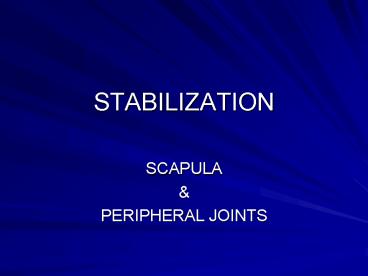STABILIZATION PowerPoint PPT Presentation
1 / 19
Title: STABILIZATION
1
STABILIZATION
- SCAPULA
- PERIPHERAL JOINTS
2
RHOMBOID MAJOR AND MINOR
STABILIZATION
MOTIONS
Prevents abduction (protraction) Prevents
winging Prevents depression
Scapular elevation Scapular adduction (retraction
)
3
UPPER TRAPEZIUS
MOTIONS
STABILIZATION
Prevent Scapular Depression Stabilize
Scapula For Humeral Elevation
Elevate Scapula Upward Rotate Scapula
4
LOWER TRAPEZIUS
MOTIONS
STABILIZATION
Prevent Protraction and Elevation of
Scapula Anchor Scapula For Upward Rotation In
Humeral Elevation
Depress Scapula Retract Scapula
5
MIDDLE TRAPEZIUS
STABILIZATION
MOTIONS
Prevent Protraction of Scapula Anchor
Scapula For Upward Rotation In Humeral
Elevation
Retract Scapula
6
LEVATOR SCAPULAE
UPPER 3-4 TRANSVERSE PROCESSES
MOTIONS
STABILIZATION
Elevate Scapula
Prevent Scapular Depression
7
SERRATUS ANTERIOR
MOTIONS
STABILIZATION
Prevents Scapular Winging
Protract Scapula Upward Rotation Of Scapula for
Humeral Elevation
8
PECTORALIS MINOR
STABILIZATION
MOTIONS
Prevents Scapular Retraction Prevents Scapular
Abduction
Scapular Protraction
9
SCAPULAR TENDENCY(Common Scapular Abnormalities)
- Postural Protraction
- Postural Elevation/Excessive Elevation during
movement - Postural Winging/Winging during movement
10
SCAPULAR INFLUENCE ON GHJ
- DECREASED STABILITY OF SCAP
- CHANGE IN GLENOHUMERAL ALIGNMENT
- DECREASE SUBACROMIAL SPACE
- INCREASE IMINGEMENT OF STRUCTURES BETWEEN
ACROMION AND HUMERAL HEAD - EXAMPLE
11
INFLUENCE ON CERVICAL ALIGNMENT/BIOMECHANICS
- INCREASED CERVICAL LORDOSIS
- SHORTENED MUSCLES (Upper trap, levator scap,
sterncleidomastoid) - INCREASED FACET IMPINGEMENT
- CLOSING OF INTERVERTEBRAL FORAMEN
12
COORDINATION
- TRAIN TO DECREASE M. TONE/ACTIVITY
- TRAIN TO INCREASE M. FLEXIBILITY
- TRAIN TO INCREASE M. ACTIVITY
- TRAIN TO INCREASE M. STRENGTH
- Strength does not always M activity
- Flexibility does not always M activity
13
STRENGTH
- LOWER TRAP
- MIDDLE TRAP
- RHOMBOIDS
- ISOLATE!
14
FLEXIBILITY
- UPPER TRAP
- LEVATOR SCAPULA
- PEC MINOR
- MASSAGETRIGGER POINT PRESSUREBIOFEEDBACKSTRETCH
15
SCAPULAR STABILITY AND SHOULDER OVERUSE
- Fitzgibbon 1994
- Irish Nat Swim Team
- Examined length of M.s (pec, m trap, low trap)
- Measured onset of activiation
- Measusred max EMG of pec minor, mid trap, lower
trap, delt - Swimmers and controls with shorter pec min poor
firing pattern (Delts come in earlier than upper
trap and lower trap fires less or late) - Particularly swimmers with overuse injuries
16
SCAPULAR STABILITY AND SHOULDER OVERUSE
- Lauzon (UCLA)
- Shoulder probs in swimmers due to weak scap M.s
- Lower trap weak compared to upper trap
- Latissimus excessively tight
- Treatment
- Ice, US, X friction of overused tissues
- Mandatory icing after practice
- Specific individual exercises for some swimmers
- Coach, ATC, athlete work together
- Do not overstretch inferior capsule
- Crosstraining to prevent overuse
17
PERIPHERAL JOINT STABILITY
- EXAMPLES
- Subluxing patella
- Subluxing GH joint
- Recurrent ankle sprain
- STATIC vs. DYNAMIC STABILITY
- COORDINATION AS PART OF STABILIZTION
18
FUNCTIONALLY UNSTABLE ANKLES (Rozzi et al, 1999)
- 13 unstable, 13 unimpaired subjects
- Biodex Stability System (Visual Feedback)
- Program 3x/wk, 4 wk training on Biodex
- Unstable ankles improved significantly, as did
unimpaired ankles. Untreated ankles also improved
19
7
6
5
4
3
2
1
0
Pre Training
Post Training

